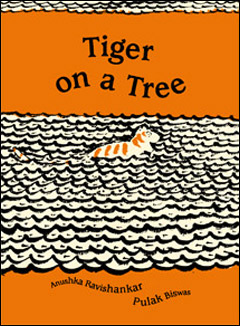Anushka Ravishankar and Pulak Biswas
Tiger on a Tree
Ravishankar, Anushka; Pulak Biswas;
Tiger on a Tree
Tara Publishing 1997 / Farrar Straus and Giroux 2004, 35 pages [gbook]
ISBN 8186211357, 9788186211359
topics: | children | picture-book | india | english | poetry
Tiger on a Tree is one of the pathbreaking books in Indian children's literature. Unfortunately it is much better known abroad than within India.
In the 80s', Pulak Biswas, a senior artist trained at the Government Arts college, Calcutta, turned down a lucrative career in advertising to join Shankar and the Children's Book Trust, and quickly became well known in Indian children's book circles. This story, initially conceived and illustrated by Biswas, was presented at a workshop with Tara Publishing in the mid-90s, but the text sparkled after it was converted into whimsical rhyme by Anushka Ravishankar.
The story
A tiger is wandering along the shore of the river. Does it want to go across? Will it be bold? will it be brash? Splash! and it swims across, to end up near a village.
The tiger encounters an angry goat who terrifies him into running up a tree.
The story is probably set in the Sunderbans, where tigers encroaching on fisherman's villages is commonplace). The villagers are amazed: Tiger on a tree? Rubbish - cannot be. It's true I saw it too! Now what to do?The illustrations are whimsical, the rhytms of the poetry accentuated by the rhythmically jumping text. Eventually, the fishermen lay a net around the tree and beat drums and blow horns until the orange and black tiger runs into the trap. But then, the villagers don't know what to do with a live tiger on their hands: "Send him to the zoo? Stick him up with glue? Paint him an electric blue?"
The text leaps across pages like the tiger, or it splashes over the page, like a river. The book was an international critical success, and in 1999, it was selected for the UNESCO-sponsored Biennale of Illustrations Bratislava, a prestigious international exhibition for illustrations from a children's book. The pictures illustrate these villagers in traditional clothing and black skin, and evoke the humour of their sun-darkened lives. The book was also an American Library Association (ALA) notable book in 2005. It has been translated into some 14 languages, includign French, German, Japanese, Italian, and Korean. Note: the Tara publishing website says it won the "Andersen award" in 2004, presumably the Hans Christian Andersen award. But that award website does not list this book among its winners. In the end, of course, the villagers let him go, and he gets lost in the jungle. Unfortunately, this book seems to have gotten lost as well, for it is very difficult to find in India. - Amit Mukerjee nov 2008
Other reviews
from review in The Hindu: Tara Publishing has used innovative and unconventional illustrations and text to tell children the story of a tiger. Pulak Biswas' black and orange illustrations are set off in the beautiful handmade paper. But, says Ravishankar, she did not sit down to write the story about the tiger. Biswas had already done the illustrations at a workshop conducted by Tara earlier, and she worked on the text much later. She says she enjoys writing this way because it creates a kind of tension between the writing and the illustration. It also gives the opportunity to work with minimal text for maximum effect. ... [The book became quite popular in French schools], where one resource person stopped the story when the tiger had been caught and the text read: "What shall we do now?" The children were asked to illustrate the options. Ravishankar says she was surprised with the kind of illustrations the kids had come up with. While one of them had drawn a tiger rug, another had drawn a neatly arranged table with plate and fork and knife. And on the plate lay an orange and black striped skin. --- Kirkus reviews: A nonsense import from India tells the story of an endearingly timid tiger. Minimalist verse follows the little fellow as he intrepidly crosses a stream and then encounters a terrifying goat: "Baaaaaaaa," says the goat, and "Yaaaaaaaah!" shrieks the tiger, who flees up a tree. Thick, creamy stock supports the equally minimalist two-color illustrations (black and orange, natch), which depict a blobby little tiger with wide, distressed eyes and men of a variety of ages and body types (pot-bellies are prominent). The typography swoops and darts across the page, lending extra energy to the illustrations. The tale ends as it begins, with the "Tiger, tiger on the shore," happily returning home. Ravishankar is well-known in India for her Indian English nonsense verse and Biswas is one of the country's premier children's book illustrators; cheers to the publisher for bringing them to these shores. (Picture book. 3-6) Also see review on Sawnet ** LINK: Read excerpts from Ravishankar and Biswas' Catch that Crocodile (also from Tara Publishing) on google books.
Send your jottings to Book Excerptise
to contribute some excerpts from your favourite book to
book
excerptise. send us a plain text file with
page-numbered extracts from your favourite book. You can preface your
extracts with a short review.
email to (bookexcerptise [at] gmail [dot] com).
bookexcerptise is maintained by a small group of editors. comments are always welcome at bookexcerptise [at] gmail. This article last updated on : 2014 Feb 18
